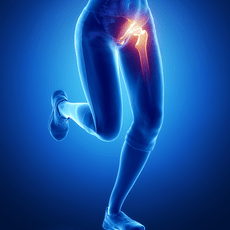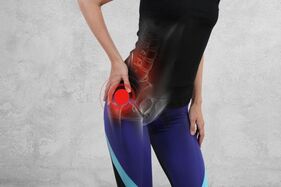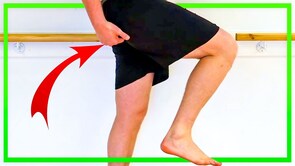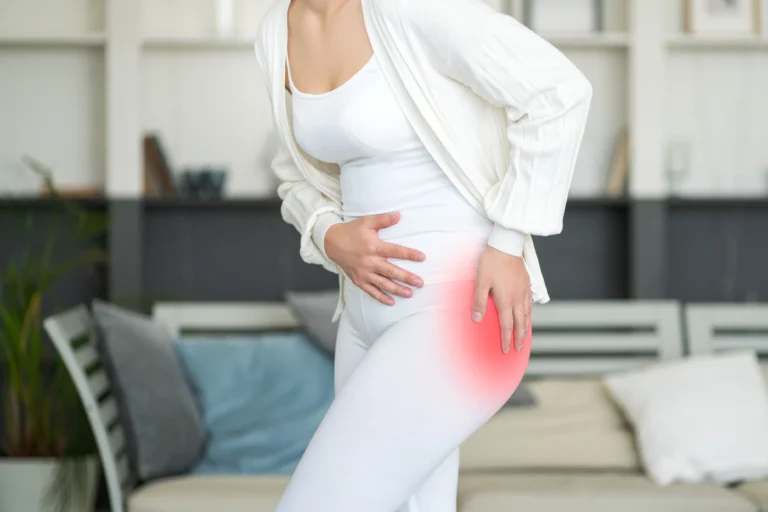
Share:
The hip is a common place for injuries in runners. The purpose of this blog post is to highlight some of the more common hip running related injuries and provide examples of hip exercises. When recovering from injury, I recommend consulting a physical therapist for specific guidance on what exercises you should be doing for your hip pain.

Gluteal tendinopathy
What is it?
Pain and tendon structure changes that occur from repetitive overuse or prolonged irritation of gluteus medius and minimus tendons.
What are the signs/symptoms?
Progressive onset lateral hip pain, especially over the greater trochanter (bony landmark on the side of your hip).
Pain often starts after a period of increase in running volume or running up/down hill
Pain may be aggravated by:
- Prolonged sitting
- sitting with legs crossed
- sleeping on your side
- running/walking (especially up/downhill)
- pain with the first few steps after prolonged sitting/inactivity
- running on cambered surface or running on in the same direction on a track

Proximal Hamstring Tendinopathy aka “a pain in the butt”
What is it?
Pain and tendon structure changes to the proximal hamstrings tendon
What are the signs/symptoms?
- Progressive onset deep buttock pain and structural tendon changes at the proximal (closest to the pelvis) insertion (ischial tuberosity) of the hamstring.
- Pain often starts after a period of increase in running volume or running uphill
- Pain may be aggravated by:
- prolonged sitting
- palpation/compression
- stairs (up/down)
- running/walking (especially uphill)
- pain with the first few steps after prolonged sitting/inactivity
- stretching the hamstrings
Femoroacetabular impingement (FAI) aka “hip impingement” and labral tears
What is it?
FAI is where there is overgrowth of either the acetabular rim (pincer abnormality) or femoral head (CAM abnormality) or both. Pain can be caused by irritation from these areas of overgrowth causing abnormal rubbing during hip movement.
The acetabular labrum is a fibrocartilage rim that deepens the socket of the hip and improves stability. A labral tear is difficult to distinguish from FAI and the two conditions often coexist. Labral tears can happen in runners when there is joint instability, especially at terminal stance phase of gait (right before back leg pushes off).
What are the signs/symptoms?
Anterior hip or groin pain that sometimes radiates to the inside of the thigh/ knee, side of the hip or back of the hip/buttock. Pain often does not have a traumatic mechanism but is associated with overuse (ie: running).
May have pain with:
- Prolonged sitting or walking
- Deep squatting or lunges
- Stairs
- Running
- Crossing legs or getting out of a car/bed
- Catching, clicking, or giving way sensation
- Loss of hip range of motion

Bone Stress Injury
What is it?
Stress reaction (precursor to stress fracture) or stress fracture from repetitive overuse or trauma, often with decreased bone mineral density. In the hip, the most common places are the femoral neck (towards the top of the thigh bone) and the pelvis.
What are the signs/symptoms?
- Pain that usually does not have a specific mechanism but can occur when increasing training/running volume
- Pain in the front of the thigh, groin, and sometimes low back or inside of the knee
- May have pain with:
- Rolling over in bed or crossing your legs
- Any weight-bearing position, especially if prolonged
- High impact activities such as running and jumping
- Pain usually is relieved by rest
- Can be tender with palpation but not always
Iliopsoas syndrome
What is it?
The iliopsoas is a hip flexor muscle located in the front of your hip and pelvis and attaching to the femur. Iliopsoas syndrome is the newer term to incorporate Iliopsoas tendinopathy, iliopsoas bursitis, and/or iliopsoas impingement. Researchers combined these three conditions into “iliopsoas syndrome” because they present similarly and are hard to distinguish between.
What are the signs/symptoms?
- Pain onset may not have a mechanism but could occur after a period of increased volume of uphill running
- Pain with walking, running, or stairs (especially upstairs or uphill)
- Pain in the front of the hip and/or same side lower back
- Possible snapping in front of hip with certain movements
Now that you know some of the common injuries, below are videos of great exercises for the hip for runners!
The first two videos show mobility exercises for the hip joint. Since these exercises target ligaments instead of muscle, they will not feel the same as a muscle stretch. It is important to use a thick band or strap that has little give for the next two exercises.
Banded Hip Mobilizations (next two videos)
The gluteus medius and minimus are primary hip stabilizers that are key for optimal running performance. These muscles are the muscles responsible for reducing excessive pelvis motion during single leg stance. Single leg stance is any time you are on one limb during the gait cycle. Excessive pelvis motion can lead to inefficient running mechanics and increase your risk for injury. The next two exercises are great exercises to really make your gluteal muscles burn! They are difficult to coordinate at first and take some practice. If you don’t have a playground ball (I’d be surprised if you did), you can use a foam roller instead.
Gluteal Isometric
Gluteal Isometric with Single Leg Squat
The next exercise works hip flexors on one side and your glutes, quads, hamstrings, and calves on the other side. It is also a functional position for runners because it replicates the movements during the running cycle.
Triple Extension with Contralateral March
The next two videos are hamstrings focused exercises. The hamstrings are responsible for slowing the leg down during the swing phase of running and are one of the most powerful muscle groups in the lower body.
Single Leg Romanian Deadlift
Hamstring Bridge on Sliders
In addition to the hamstring bridge, sliders are a great way to work split pelvis movements in a different way than traditional lunges. Split pelvis movements are important to improve balance and stability on one leg. This is important for runners because approximately 60% of the gait cycle is single limb support and 40% double limb support (both legs touching the ground). Single limb support time increases as you run faster and is the highest with sprinting. They are also helpful to use as a transition from bilateral to single leg movements.
Reverse Lunge Slider
Lateral Lunge Slider
The last exercise I am going to demonstrate is the Copenhagen adductor exercise. It is an awesome way to develop rock solid adductor strength. It can be irritating on the hip joint for some people, so if something feels off in your groin, you might want to develop adductor strength with other exercises before trying this exercise again. If you do not have a weight bench, you can do these with your foot on the couch or ottoman. For a modified version, use your knee instead of the foot for your anchor point.
Copenhagen Adductor
This blog definitely was not a comprehensive overview of running related hip injuries and exercises (that could take a book), but I did cover some of the most common injuries with exercise ideas. Contact us to set up an evaluation if you want to know more about your specific injury!
Disclaimer: This content is designed for information & education purposes only and is not intended for medical advice.
References:
- Heiderscheit B, McClinton S. Evaluation and Management of Hip and Pelvis Injuries. Phys Med Rehabil Clin N Am. 2016 Feb;27(1):1-29. doi: 10.1016/j.pmr.2015.08.003. PMID: 26616175.
- Ishøi L, Sørensen CN, Kaae NM, Jørgensen LB, Hölmich P, Serner A. Large eccentric strength increase using the Copenhagen Adduction exercise in football: A randomized controlled trial. Scand J Med Sci Sports. 2016 Nov;26(11):1334-1342. doi: 10.1111/sms.12585. Epub 2015 Nov 21. PMID: 26589483.
- Grimaldi A, Mellor R, Hodges P, Bennell K, Wajswelner H, Vicenzino B. Gluteal Tendinopathy: A Review of Mechanisms, Assessment and Management. Sports Med. 2015 Aug;45(8):1107-19. doi: 10.1007/s40279-015-0336-5. PMID: 25969366.
- Wright AA, Hegedus EJ, Taylor JB, Dischiavi SL, Stubbs AJ. Non-operative management of femoroacetabular impingement: A prospective, randomized controlled clinical trial pilot study. J Sci Med Sport. 2016 Sep;19(9):716-21. doi: 10.1016/j.jsams.2015.11.008. Epub 2016 Jan 6. PMID: 26795448.
Get in touch with us
* indicates required fields






